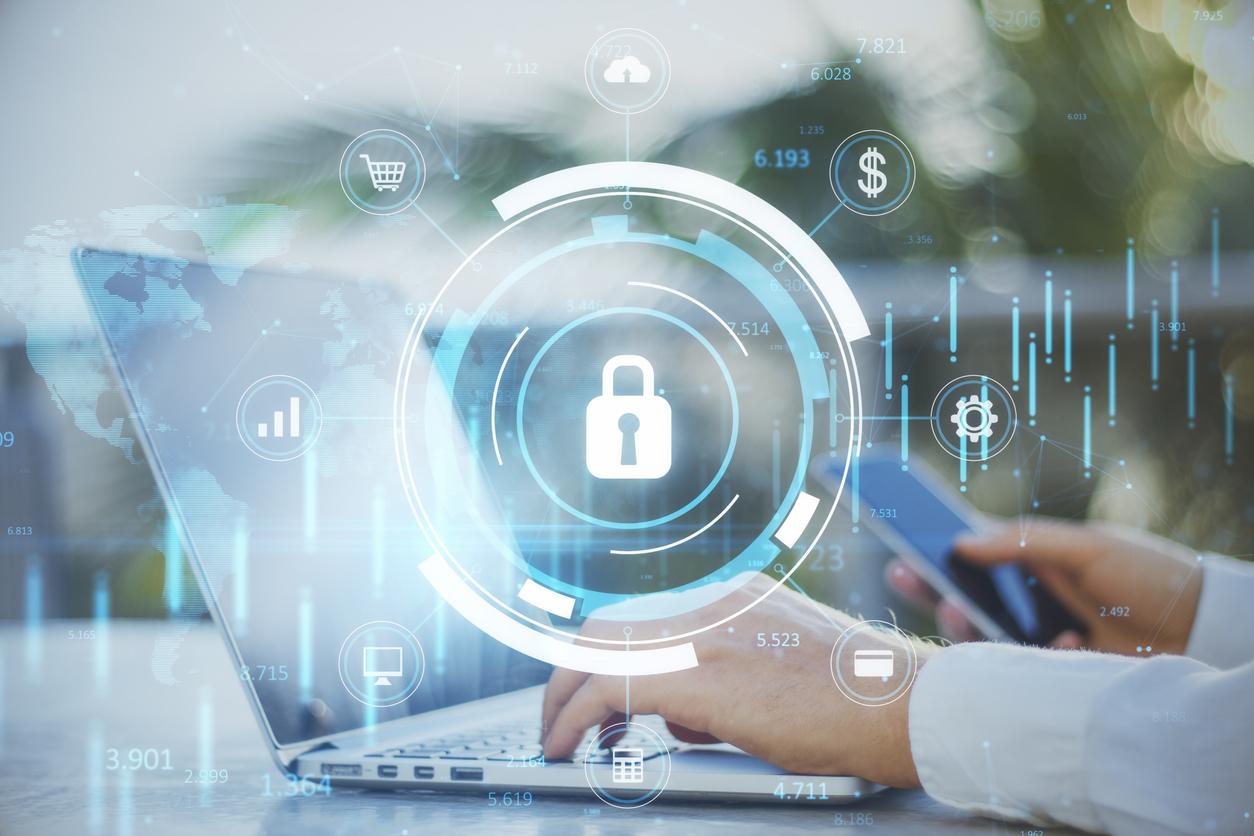
Close up of businessman hand using laptop keyboard and smartphone with glowing blue padlock hologram with forex chart and map on blurry outdoor background, Secure and online safety concept. Double exposure
Cyber attacks threaten logistics companies on a daily basis. Learn 5 practical steps that can help you avoid or mitigate potential damage.
IT hacks are a constant concern for companies in the logistics industry. Sensitive information is shared between companies, customers, and suppliers on a daily basis and the threat of a breach is real. The potential consequences include financial loss, damage to reputation, and disruption to operations. Organizations must take action to protect themselves against cyber hacks. Here are five key ways logistics companies can mitigate the impact of IT hacks.
Invest in Cybersecurity to Protect Your Network
An investment in key cybersecurity measures is the first step in protecting your company from attack. This includes:
Firewall Protection
A firewall will monitor incoming and outgoing traffic in order to protect your network from unauthorized access.1 By filtering this traffic, it aims to prevent malicious files from introducing malware into your system.
A firewall can be your first line of defense to guard the perimeter of your network. Unfortunately, firewalls can be vulnerable to phishing attacks or employees who use their legitimate accounts in a malicious manner.
Anti-Virus Software
Anti-virus software will scan files and incoming emails in order to detect viruses and malicious software. It will provide valuable warnings about dangerous websites and offer defense against identity theft and other types of fraud. It can also scan the dark web to determine if your email address has been compromised.
Security Patches and Updates
In order for security measures to work properly, it’s essential that they remain up to date. Hackers will target known vulnerabilities in popular software and security tools. The software companies will, in turn, create updates to address these exposures. Installing these updates is a key component of an effective cybersecurity program.
Train Employees in Order to Reduce Vulnerabilities
Employees must understand that they are a vital component of your organization’s cybersecurity effort. Implement defense policies and discuss them with your staff regularly.
Phishing attacks are a constant threat, so train your staff to smell a rat!2 Urgent action demands or requests for login credentials and other sensitive information should be viewed suspiciously, as should offers that are too good to be true.
Passwords should be strong and changed periodically. Unauthorized users or software should be prohibited on company devices. Create an atmosphere where employees feel free to ask questions and seek advice on cybersecurity.
Tip: Use a simulated phishing campaign to test your staff’s preparedness. Discuss the results and strengthen protocol where necessary.
Back Up Data to Mitigate Potential Damage
Cyber hacks can cause data deletion, corruption, or encryption. Those who back up their data to an air-gapped location3 regularly will be better positioned to quickly restore their systems to their previous states, minimizing lost work or downtime.
Frequent backups are a good practice in general. Not only will the backups pay off in the event of a cyberattack, but will also prove valuable if hardware failure or human error results in data loss.
Develop a Response Plan to Recover Quickly
If preventing a breach proves impossible, a response plan will inform swift, appropriate action after the fact.
Begin by identifying the type of attack (virus, malware, ransom, or phishing?). Contain it by isolating the affected systems. Relevant parties should be notified quickly. This will include senior management, the IT team, and law enforcement. Clients, too, will need to be informed in cases where their data has been compromised or if they’ll be affected by service disruptions.
Assess the damage and work quickly to recover. Once immediate concerns have been addressed, it’s time to investigate the source of the attack and address vulnerabilities in your security protocol.
It’s a good idea to have a plan in place regarding the designation of post-attack responsibilities. This could include members of your internal team or experts from outside the company.
Conduct Regular Audits to Assess Preparedness
Audits of your cybersecurity program will help you identify vulnerabilities and provide you peace of mind. A credible third party will conduct an in-depth review of your organization’s security measures, including policies, procedures, and controls. This should assess the effectiveness of your program both in terms of how it’s written and how it’s actually implemented.
By taking these proactive measures, logistics companies can protect themselves against the potential damages of a cyber attack. The effort must be ongoing and team-wide. Given the important role that logistics plays in our day to day lives, a strong defense system is not only a company imperative, but a societal one.
Cited Sources
1 Dosal, Eric. “Firewall Security: How to Protect Your Network from Firewall Hacking.” Cybersecurity Solutions. Compuquip Cybersecurity, September 15, 2021. https://www.compuquip.com/blog/protect-network-firewall-hacking.
2 Hebert, Amy, Alesha Hernandez, Rhonda Perkins, and Alvaro Puig. “How to Recognize and Avoid Phishing Scams.” Consumer Advice, October 25, 2022. https://consumer.ftc.gov/articles/how-recognize-and-avoid-phishing-scams.
3 Pritchard, Stephen. “Top Five Ways Backup Can Protect against Ransomware: Computer Weekly.” ComputerWeekly.com. ComputerWeekly.com, September 24, 2020. https://www.computerweekly.com/feature/Top-five-ways-backup-can-protect-against-ransomware.
